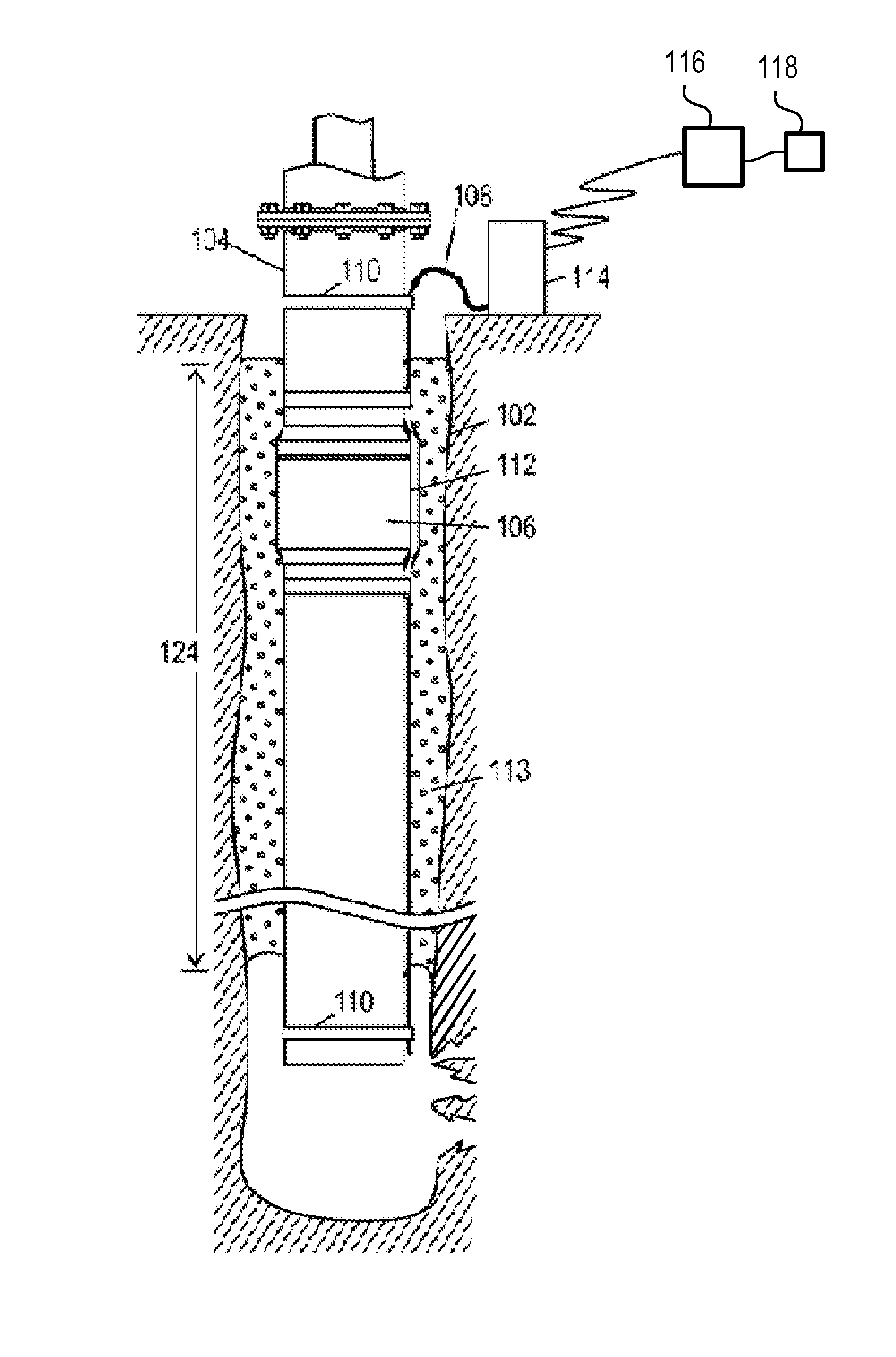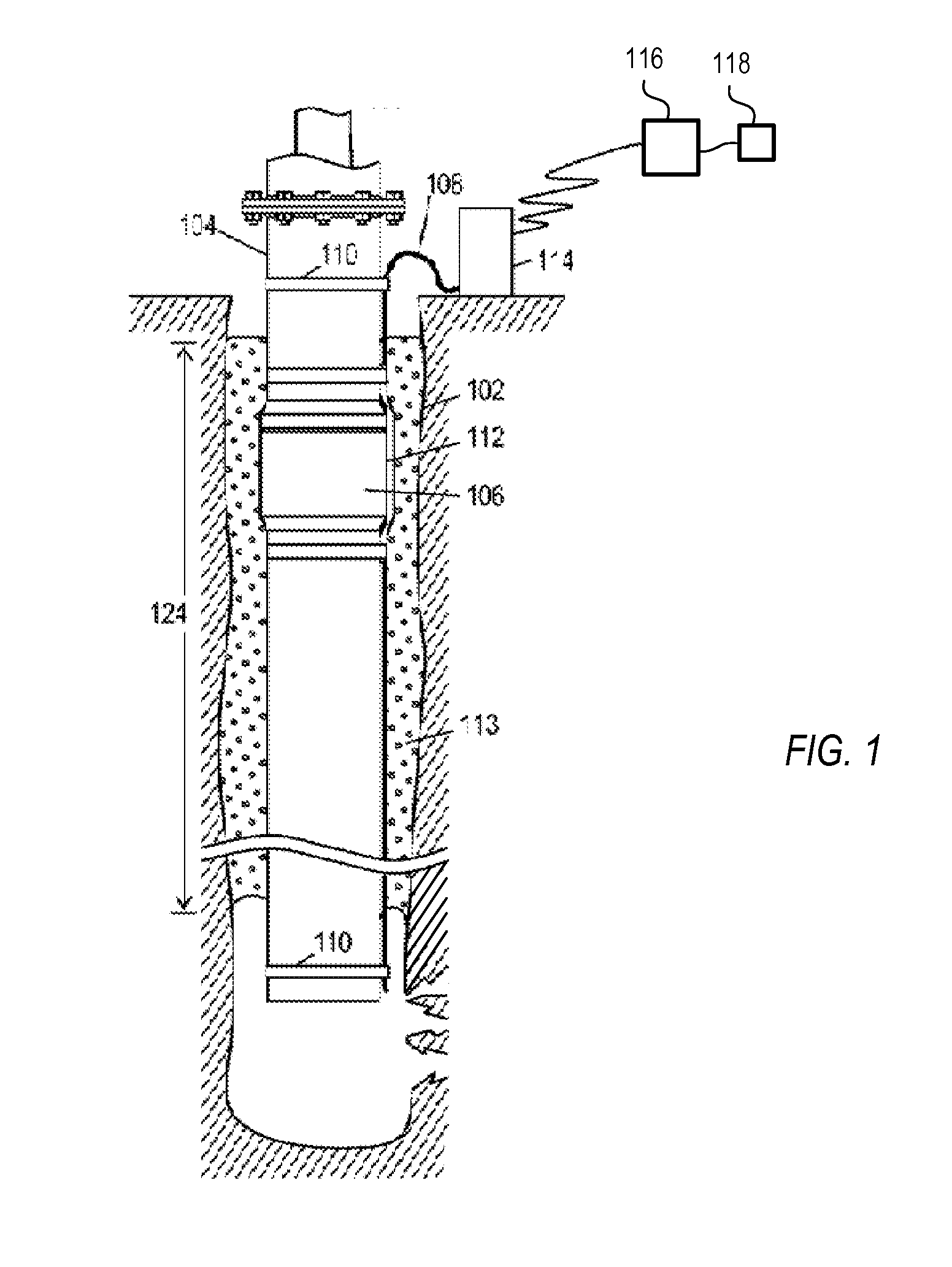Multiplexed fiber optic sensing system and method
a fiber optic and sensing system technology, applied in the field of multi-channel fiber optic sensing systems and methods, can solve the problems of optical fiber-based sensing systems, channel count, and the inability to use more than a handful of optical sensing channels, and achieve the effect of increasing bandwidth
- Summary
- Abstract
- Description
- Claims
- Application Information
AI Technical Summary
Benefits of technology
Problems solved by technology
Method used
Image
Examples
example 1
[0089]FIG. 8 is a schematic drawing of a first example interrogation module 800, which includes a single Michelson interferometer 806 that converts a wavelength shift to a phase shift, followed by a CWDM 818 to separate the four data channels from one another, followed by a 4-by-N channel WDM / TDM demodulator 820 that converts a phase shift to an intensity that is detectable on a detector, and also matches a sensed set of spectra with the proper sensor. In some examples, as depicted in FIG. 1, the interrogation module, as well as the light source, may be considered as a part of the processing assembly 114.
[0090]In this example interrogation module 800, the output fiber 726 delivers pulsed light having a spectrum that may be analyzed to extract data sensed from a corresponding sensor. The spectrum has four peaks, where the peak wavelength of each peak is indicative of a sensed acceleration value. The pulses are delivered to an amplifier 804. An example of a suitable amplifier 804 is a...
example 2
[0098]FIG. 9 is a schematic drawing of a second example interrogation module 900, which includes a CWDM 906 to separate the four data channels from one another, followed by four Michelson interferometers 908, 910, 912, 914 that each converts a wavelength shift to a phase shift, followed by a 4-by-N channel WDM / TDM demodulator 820 that converts a phase shift to an intensity that is detectable on a detector, and also matches a sensed set of spectra with the proper sensor.
[0099]In this example interrogation module 900, the output fiber 726 delivers pulsed light to an amplifier 904. The amplified pulses from the optical amplifier 904 pass through a CWDM 906, which separates them into the four data channels X, Y, Z, H. Light in each of the four data channels is directed to its own Michelson interferometer 908, 910, 912, 914. Each Michelson includes first and second paths, as described above, with the second path in each including a PZT-base modulator 924, 926, 928, 930. These four modula...
example 3
[0102]FIG. 10 is a schematic drawing of a third example interrogation module 1000, which includes a 3-by-3 coupler 1006 that couples light into and out of a Michelson interferometer that converts a wavelength shift to a phase shift, the 3-by-3 having three outputs, each of which is directed into a respective CWDM 1016, 1018, 1020 that separates the four data channels from one another, followed by four 1-by-N channel WDM / TDM demodulators 1024, 1026, 1028, 1030 that convert a phase shift to an intensity that is detectable on a detector, and also match a sensed set of spectra with the proper sensor. Note that the four 1-by-N WDM / TDM demodulators are functionally equivalent to the single 4-by-N WDM / TDM demodulator discussed above.
[0103]In this example interrogation module 1000, the output fiber 726 delivers pulsed light to a first port of a circulator 1004. The pulses exit through a second port of the circulator 1004 and are directed toward one of three input ports in a 3-by-3 coupler 1...
PUM
 Login to View More
Login to View More Abstract
Description
Claims
Application Information
 Login to View More
Login to View More - R&D
- Intellectual Property
- Life Sciences
- Materials
- Tech Scout
- Unparalleled Data Quality
- Higher Quality Content
- 60% Fewer Hallucinations
Browse by: Latest US Patents, China's latest patents, Technical Efficacy Thesaurus, Application Domain, Technology Topic, Popular Technical Reports.
© 2025 PatSnap. All rights reserved.Legal|Privacy policy|Modern Slavery Act Transparency Statement|Sitemap|About US| Contact US: help@patsnap.com



